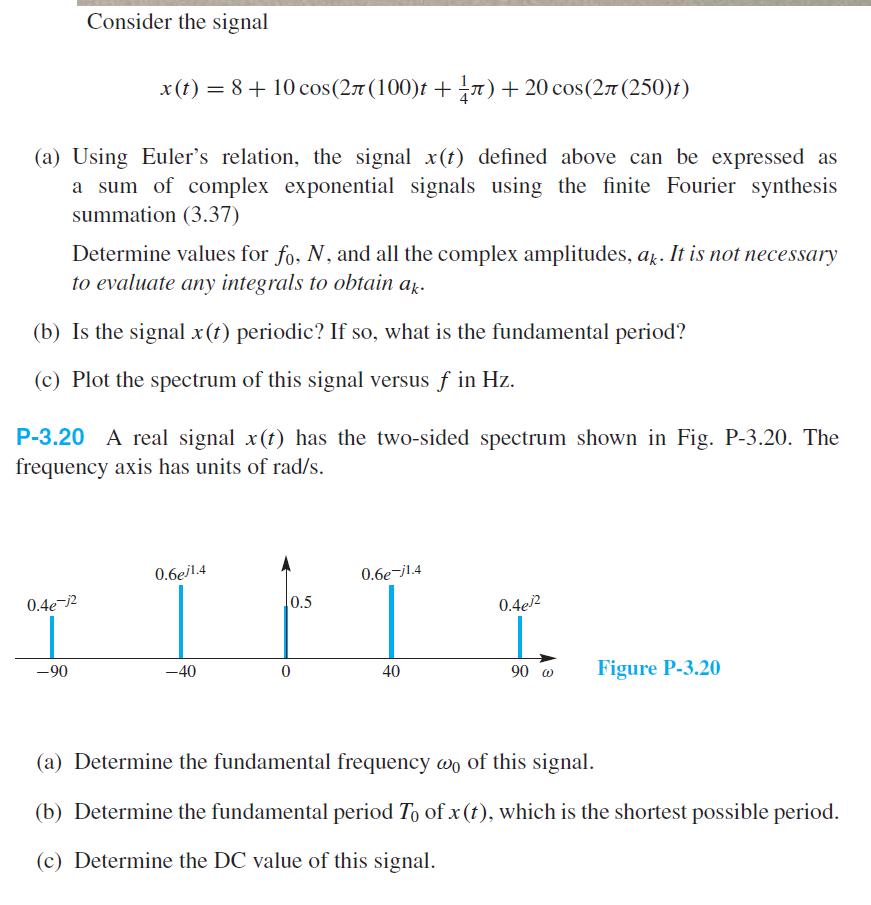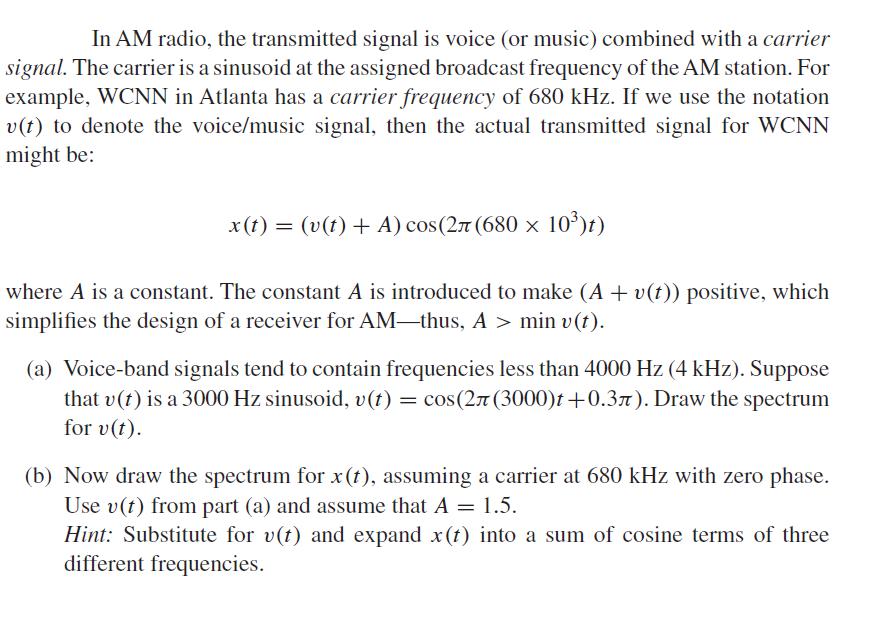Answered step by step
Verified Expert Solution
Question
1 Approved Answer
Consider the signal (a) Using Euler's relation, the signal x(t) defined above can be expressed as a sum of complex exponential signals using the


Consider the signal (a) Using Euler's relation, the signal x(t) defined above can be expressed as a sum of complex exponential signals using the finite Fourier synthesis summation (3.37) x (t) = 8 + 10 cos(2 (100)t + r) +20 cos (2 (250)t) Determine values for fo, N, and all the complex amplitudes, ak. It is not necessary to evaluate any integrals to obtain ak. (b) Is the signal x (t) periodic? If so, what is the fundamental period? (c) Plot the spectrum of this signal versus f in Hz. 0.4e-j2 P-3.20 A real signal x(t) has the two-sided spectrum shown in Fig. P-3.20. The frequency axis has units of rad/s. -90 0.6e/1.4 -40 0.5 0 0.6e-j1.4 40 0.4e2 90 @ Figure P-3.20 (a) Determine the fundamental frequency wo of this signal. (b) Determine the fundamental period To of x (t), which is the shortest possible period. (c) Determine the DC value of this signal. In AM radio, the transmitted signal is voice (or music) combined with a carrier signal. The carrier is a sinusoid at the assigned broadcast frequency of the AM station. For example, WCNN in Atlanta has a carrier frequency of 680 kHz. If we use the notation v(t) to denote the voice/music signal, then the actual transmitted signal for WCNN might be: x (t) = (v(t) + A) cos(27 (680 x 10)t) where A is a constant. The constant A is introduced to make (A + v(t)) positive, which simplifies the design of a receiver for AM-thus, A > min v(t). (a) Voice-band signals tend to contain frequencies less than 4000 Hz (4 kHz). Suppose that v(t) is a 3000 Hz sinusoid, v(t) = cos(2 (3000)t +0.37). Draw the spectrum for v(t). (b) Now draw the spectrum for x (t), assuming a carrier at 680 kHz with zero phase. Use v(t) from part (a) and assume that A = 1.5. Hint: Substitute for v(t) and expand x(t) into a sum of cosine terms of three different frequencies. Consider the signal (a) Using Euler's relation, the signal x(t) defined above can be expressed as a sum of complex exponential signals using the finite Fourier synthesis summation (3.37) x (t) = 8 + 10 cos(2 (100)t + r) +20 cos (2 (250)t) Determine values for fo, N, and all the complex amplitudes, ak. It is not necessary to evaluate any integrals to obtain ak. (b) Is the signal x (t) periodic? If so, what is the fundamental period? (c) Plot the spectrum of this signal versus f in Hz. 0.4e-j2 P-3.20 A real signal x(t) has the two-sided spectrum shown in Fig. P-3.20. The frequency axis has units of rad/s. -90 0.6e/1.4 -40 0.5 0 0.6e-j1.4 40 0.4e2 90 @ Figure P-3.20 (a) Determine the fundamental frequency wo of this signal. (b) Determine the fundamental period To of x (t), which is the shortest possible period. (c) Determine the DC value of this signal. In AM radio, the transmitted signal is voice (or music) combined with a carrier signal. The carrier is a sinusoid at the assigned broadcast frequency of the AM station. For example, WCNN in Atlanta has a carrier frequency of 680 kHz. If we use the notation v(t) to denote the voice/music signal, then the actual transmitted signal for WCNN might be: x (t) = (v(t) + A) cos(27 (680 x 10)t) where A is a constant. The constant A is introduced to make (A + v(t)) positive, which simplifies the design of a receiver for AM-thus, A > min v(t). (a) Voice-band signals tend to contain frequencies less than 4000 Hz (4 kHz). Suppose that v(t) is a 3000 Hz sinusoid, v(t) = cos(2 (3000)t +0.37). Draw the spectrum for v(t). (b) Now draw the spectrum for x (t), assuming a carrier at 680 kHz with zero phase. Use v(t) from part (a) and assume that A = 1.5. Hint: Substitute for v(t) and expand x(t) into a sum of cosine terms of three different frequencies.
Step by Step Solution
★★★★★
3.49 Rating (152 Votes )
There are 3 Steps involved in it
Step: 1
To determine the number of teeth on all the wheels and the exact pitch circle diameter of A we can f...
Get Instant Access to Expert-Tailored Solutions
See step-by-step solutions with expert insights and AI powered tools for academic success
Step: 2

Step: 3

Ace Your Homework with AI
Get the answers you need in no time with our AI-driven, step-by-step assistance
Get Started


